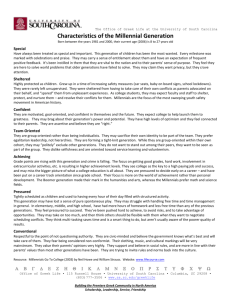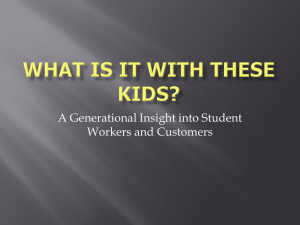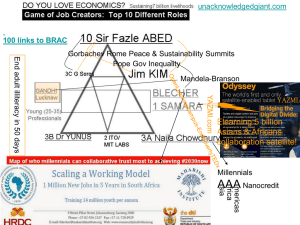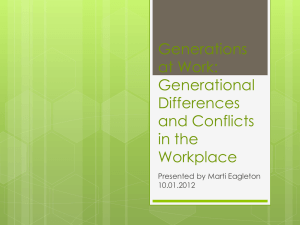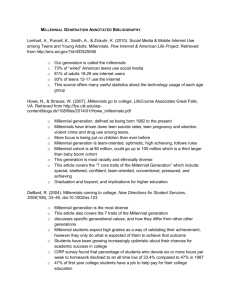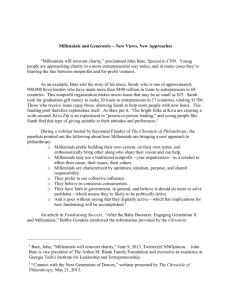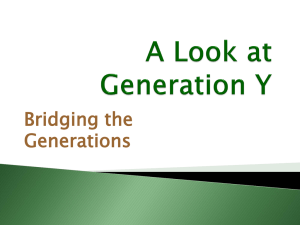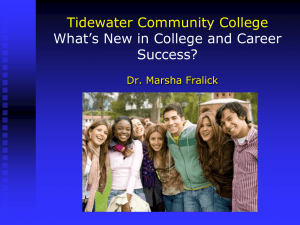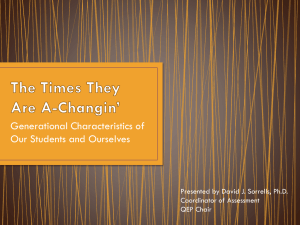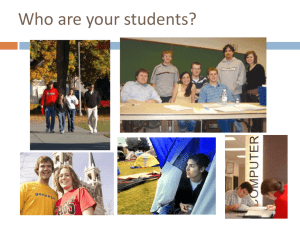Millennials overview
advertisement
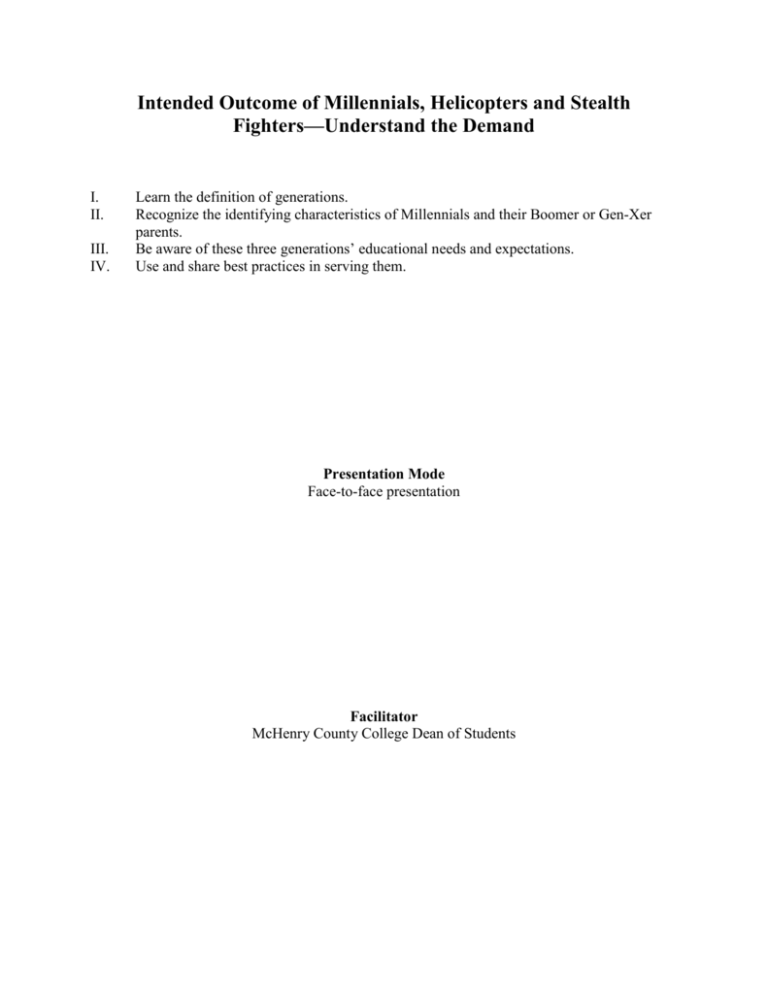
Intended Outcome of Millennials, Helicopters and Stealth Fighters—Understand the Demand I. II. III. IV. Learn the definition of generations. Recognize the identifying characteristics of Millennials and their Boomer or Gen-Xer parents. Be aware of these three generations’ educational needs and expectations. Use and share best practices in serving them. Presentation Mode Face-to-face presentation Facilitator McHenry County College Dean of Students I. II. III. IV. V. VI. According to Howe and Strauss, the following factors define a generation. a. Socially and historically significant boundaries. b. Shared “age location in history.” c. A “collective persona and set of shared beliefs.” The twentieth century has five distinct generations. a. GI Generation (1901 – 24) b. Silent Generation (1925 – 42) c. Boomers (1943 – 60) d. Gen X (1961 – 81) e. Millennials (1981 – 200?) Six factors help define the Millennial generation. a. Born between 1982 – 2002. b. Graduated from high school approximately 2000. c. Lowest child-to-parent ratio in U.S. history. d. “Quality Education” an issue = NCLB. e. Often compared to GI Generation. f. Grew up when all the following were in decline: i. Poverty ii. Divorce iii. Abortion iv. Homicide of children Five events have helped shape the Millennials. a. Columbine and subsequent school violence. b. The 2000 presentational election (Bush vs. Gore). c. 9/11. d. Large-scale natural disasters: i. Ivan ii. Katrina iii. Indonesian Tsunami iv. Chinese earthquake e. Wars involving the U.S. i. First Gulf War (H.W. Bush) ii. Second Gulf War (G.W. Bush) iii. Afghanistan Millennials possess seven core traits. a. Feeling “special” b. Being “sheltered” c. Confident d. Team-oriented e. Conventional f. Pressured externally, internally g. Achievement-driven Millennials feel special. a. The original “Baby on Board” babies. b. Preceding generations have imbued them with national importance. c. They fulfill their parents’ sense of purpose. VII. VIII. IX. X. XI. XII. Millennials are sheltered. a. Born into an era of fear and increased concern for safety. i. 80’s child-abuse scandals. ii. Safety rules, equipment, and devices. iii. Post-Columbine lockdowns. b. Worried parents became avid consumers. i. Nanny-cams. ii. Checking out/vetting daycare, doctors, schools, toys, etc. c. U.S. laws and regulations are now based on that sweeping youth safety movement. Millennials are confident. a. They possess high levels of trust and optimism. b. Good news for me = Good news for U.S. c. Looking for “balance” in life. d. Prefer contributing to betterment of society than to having lots of money. Millenials are team-oriented. a. Television, sports and schools unite Millenials. i. Barney ii. Soccer iii. School uniforms b. Schools emphasize cooperative (group) learning. c. Educators harness peer pressure. i. Enforce rules ii. Student juries iii. Peer grading d. Developing strong team instincts and close peer bonds. Millennials are pressured by parents and society. a. Parental pressures include: i. Study hard ii. Avoid personal risks iii. “Trophy Kid” status b. Societal pressures include: i. Psychological/emotional pressure 1. To be successful 2. To make a positive contribution ii. To be strong, healthy 1. Most medicated generation in U.S. history 2. Suffer physical and emotional ills to attain this goal. Millennials can be characterized by the four P’s a. Pressured b. Parents c. Praised d. Planned Special concerns educators have in teaching them are twofold. a. They can’t define cheating or plagiarism because of i. Group work ii. Team study iii. Take-home tests iv. Open-ended problem solving v. “cut and paste” vi. Wikis, Internet, Blogs b. Can educators meet millennials technological needs and expectations? XIII. According to Jason Frand of Educause, serving Millennials has the following four implications. a. “Zero tolerance for delays” i. Instant messaging and text messaging ii. On-line consumerism b. “Consumer” and “creator” roles are blurring i. File sharing ii. Digital music iii. You tube c. “Computers aren’t technology” d. “Reality is no longer real” XIV. The multiple implications of ever-increasing parental involvement are varied and numerous. a. Millennials born between 1982 and 1990 have Boomer parents. b. Boomers, known as “Helicopter” parents have the following mindset. i. They enlist a “team” to resolve problems/concerns of their children. ii. They see education as worth the time and money. c. They want to “participate” in their children’s education. d. Millennials born after 1990 likely have Gen-Xer parents. e. Gen-Xers, known as “Stealth Fighter” parents have the following mindset. i. They were the first “latch key” children. ii. They mistrust institutions. iii. Being very entrepreneurial, they focus on the bottom line. iv. Higher education was a burden for them. v. Many were self-taught. 1. “Idiots guide to…” 2. “… for Dummies” f. For their children, Stealth Fighter parents will do the following: i. Apply Fed-Ex test to all products, information and services a. “cheerful” b. “fast” (real time) 1. “efficient” (online and 24/7) 2. They take quick decisive action. 3. They assume anything immeasurable is untrustworthy. 4. They want proof that money spent is a good investment. a. “co-purchase” will be “executive co-purchase” b. Demand consequences c. Schools should be run like businesses d. Menu-driven curriculums (Dell computer model) XV. Questions for educators and educational services providers. a. What changes have you noticed? b. How will we adapt to meet the students’ and parents’ needs? c. What specific areas will need to become a focus for serving them? d. What successful best practices have you used?
